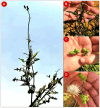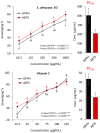Chemical Composition, Antioxidant, and Cytotoxic Activity of Essential Oils in the Above-Ground Parts of Sonchus oleraceus L
- PMID: 38931144
- PMCID: PMC11207314
- DOI: 10.3390/plants13121712
Chemical Composition, Antioxidant, and Cytotoxic Activity of Essential Oils in the Above-Ground Parts of Sonchus oleraceus L
Abstract
Sonchus oleraceus L. is a leafy vegetable that is usually consumed in the area of the Mediterranean and is a frequently used traditional herb to treat a variety of ailments. Previous studies deduced the potent antioxidant and cytotoxic functions of the different extracts and isolated compounds from S. oleraceus. The current study represents the first instance of chemical profiling and bioactivities of the extracted essential oil (EO) of S. oleraceus. The present investigation set out to identify the chemical components of this EO by means of Gas Chromatography with Flame Ionization Detector (GC-FID) and Gas Chromatography-Mass Spectrometry (G004-MS) techniques; assess the oil's antioxidant potencies through 1,1-diphenyl-2-picrylhydrazyl (DPPH) and 2,2'-azinobis-(3-ethylbenzothiazoline-6-sulfonate (ABTS) assays; and evaluate the oil's cytotoxic impact against HepG2 cancer cell lines. The GC-MS chemical profiling revealed the identification of 23 components representing 97.43% of the total oil mass within abundant cyclic ketones (20.15%), nonterpenoidial hydrocarbons (28.77%), and sesquiterpenes (42.19%). The main components were n-nonadecane (28.77%), trans-caryophyllene (23.73%), trans-methyl dihydrojasmonate (19.55%), and cis-cadina-1,4-diene (9.44%). In a dose-dependent manner, this EO demonstrated antioxidant capacities on DPPH and ABTS, with IC50 values of 609.35 and 804.16 µg/mL, respectively, compared to ascorbic acid. Using doxorubicin as a reference therapy, the MTT assay findings revealed that this oil had remarkable inhibitory effects on the proliferation of HepG2 cancer cell lines, with an IC50 of 136.02 µg/mL. More studies were recommended for further investigation of new biological roles for this oil and its main components, along with the construction of action mechanisms based on chemical components.
Keywords: Sonchus oleraceus; anticancer; antioxidant; chemical profile; trans-caryophyllene; volatile components.
Conflict of interest statement
The authors declare no conflicts of interest.
Figures




Similar articles
-
Metabolomics Profiling of Tunisian Sonchus oleraceus L. Extracts and Their Antioxidant Activities.Chem Biodivers. 2023 Aug;20(8):e202300290. doi: 10.1002/cbdv.202300290. Epub 2023 Jul 21. Chem Biodivers. 2023. PMID: 37391386
-
Chemical Composition of Kickxia aegyptiaca Essential Oil and Its Potential Antioxidant and Antimicrobial Activities.Plants (Basel). 2022 Feb 23;11(5):594. doi: 10.3390/plants11050594. Plants (Basel). 2022. PMID: 35270064 Free PMC article.
-
Prevalence of Diterpenes in Essential Oil of Euphorbia mauritanica L.: Detailed Chemical Profile, Antioxidant, Cytotoxic and Phytotoxic Activities.Chem Biodivers. 2021 Jul;18(7):e2100238. doi: 10.1002/cbdv.202100238. Epub 2021 Jun 7. Chem Biodivers. 2021. PMID: 34033700
-
Chemical composition and biological activity of the essential oil obtained from Bupleurum marginatum (Apiaceae).J Pharm Pharmacol. 2009 Aug;61(8):1079-87. doi: 10.1211/jpp/61.08.0012. J Pharm Pharmacol. 2009. PMID: 19703352
-
Chemical Composition, Enantiomeric Distribution, Antimicrobial and Antioxidant Activities of Origanum majorana L. Essential Oil from Nepal.Molecules. 2022 Sep 19;27(18):6136. doi: 10.3390/molecules27186136. Molecules. 2022. PMID: 36144869 Free PMC article. Review.
Cited by
-
Hepatoprotective action of Sonchus oleraceus against paracetamol-induced toxicity via Nrf2/KEAP-1/HO-1 pathway in relation to its metabolite fingerprint and in silico studies.PLoS One. 2025 Jun 26;20(6):e0325782. doi: 10.1371/journal.pone.0325782. eCollection 2025. PLoS One. 2025. PMID: 40569949 Free PMC article.
References
-
- Pérez-González C., Pérez-Ramos J., Alberto Méndez-Cuesta C. Cytotoxicity—Definition, Identification, and Cytotoxic Compounds. IntechOpen; London, UK: 2019. Cytotoxic activity of essential oils of some species from Lamiaceae family. - DOI
-
- Konfo T.R., Djouhou F.M., Koudoro Y.A., Dahouenon-Ahoussi E., Avlessi F., Sohounhloue C.K., Simal-Gandara J. Essential oils as natural antioxidants for the control of food preservation. Food Chem. Adv. 2023;2:100312. doi: 10.1016/j.focha.2023.100312. - DOI
Grants and funding
LinkOut - more resources
Full Text Sources
Miscellaneous

